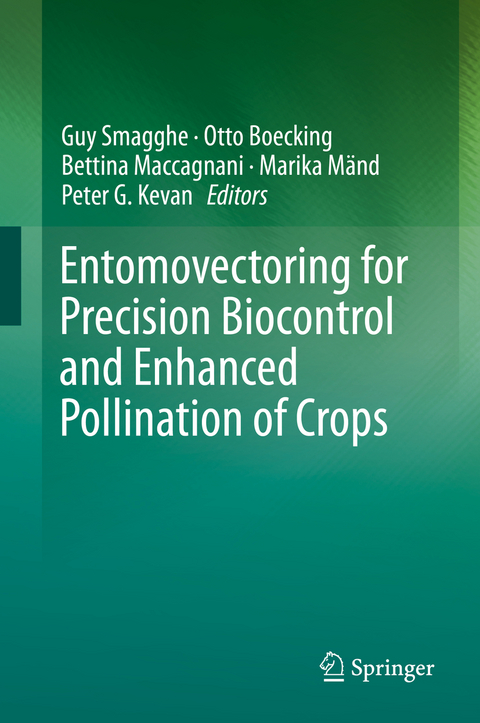
Entomovectoring for Precision Biocontrol and Enhanced Pollination of Crops
Springer International Publishing (Verlag)
978-3-030-18916-7 (ISBN)
This book focuses on entomovectoring, also known as apivectoring, the method used for managing pollinators to increase crop yields and employ strategies of biocontrol in greenhouses and open fields. It is written by experts working in academia and industry from the different continents of the world. Over the past 25 years Research and Development has successfully investigated the potential of pollinators to perform two tasks: dispersal of biological control agents (BCOs) and their pollination service. This book provides a basic overview of the current literature on the different aspects and factors of this novel technology. It explains and presents practical cases of enhancing pollination coupled with the suppression of plant pathogens and pests under various agricultural production practices from greenhouse to open field conditions and crops ranging from orchard fruits, to small and tender berries, vegetables and oil seeds
Prof. Guy Smagghe, Ghent University, Department of Crop Protection, Ghent, Belgium Dr. Otto Boecking, Institut für Bienenkunde Celle, Celle, Germany Bettina Maccagnani Ph.D., Agriculture and Environment Center, "Giorgio Nicoli", CREVALCORE, Italy Marika Mänd, Estonian University of Life Sciences, Department Plant Protection,Tartu, Estonia Prof. Dr. Peter G. Kevan, University of Guelph, School of Environmental Sciences, 5Guelph, Canada
1.Agroecosystem design supports the activity of pollinator networks.- 2. Ecological Intensification: Managing Biocomplexity and Biodiversity in Agriculture through Pollinators, Pollination and Deploying Biocontrol Agents against Crop and Pollinator Diseases, Pests, and Parasites.- 3. Bee pollination of crops: a natural and cost-free ecological service.- 4. Solitary bees as pollinators.- 5. Bumble bees and entomovectoring in open field conditions.- 6. Dispensers for entomovectoring: for every bee another type?.- 7. Cases on entomovectoring in the greenhouse and open field.- 8. A case study: Use of Prestop® Mix biofungicide in entomovectoring on apple against storage rot diseases.- 9. Threat of Drosophila suzukii as an invasive species and the potential of entomovectoring.- 10.The potential of bee vectoring in coffee in Brazil.- 11. Using bumblebees (Bombus terrestris) as bioagent vectors to control Sclerotinia head rot on sunflower in Serbia.- 12. Advances in the implementation of Beevector Technologi in Colombia: Strawberry case (Fragaria X ananassa).- 13-Making a pest beneficial: Fungus gnats [Bradysia impatiens (Diptera: Sciaridea)] as potential vectors of microbial control agents to suppress pathogens they also spread.- 14. Regulatory processes surrounding the risk assessment of microbial pesticides for pollinators.- 15. Flying Doctors for a better quality in fruit production.
| Erscheinungsdatum | 04.07.2020 |
|---|---|
| Zusatzinfo | X, 277 p. 102 illus., 78 illus. in color. |
| Verlagsort | Cham |
| Sprache | englisch |
| Maße | 155 x 235 mm |
| Gewicht | 606 g |
| Themenwelt | Naturwissenschaften ► Biologie ► Botanik |
| Naturwissenschaften ► Biologie ► Zoologie | |
| Weitere Fachgebiete ► Land- / Forstwirtschaft / Fischerei | |
| Schlagworte | bee pollination • bio control • biocontrol • biofungicide • Bumblebees • crop protection • Entomology • field assays • greenhouse assays • honeybees • microbial pesticide • microbial pesticide agriculture protection • pest control • plant pathogens • Pollination • pollinators |
| ISBN-10 | 3-030-18916-3 / 3030189163 |
| ISBN-13 | 978-3-030-18916-7 / 9783030189167 |
| Zustand | Neuware |
| Haben Sie eine Frage zum Produkt? |
aus dem Bereich


